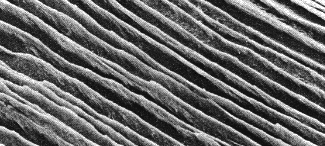Nail / Ongle
Nail recognition is an emerging biometric technology, which has not been not very much studied.
- (1999) Nailbed
- (2003) Nail RFID
- (2005) Nail plate
La reconnaissance de l'ongle est une technologie émergente, qui n'a pas encore été beaucoup étudiée.
- Base (berceau) de l'ongle
- Ongle lu par radiofréquence (RF)
- Image de l'ongle
Nailbed
Base (berceau) de l'ongle
The nailbed is an essentially parallel epidermal structure located directly beneath the fingernail formed with parallel lines spaced at intervals. During normal growth, the fingernail travels over the nailbed.
La base the l'ongle est une structure épidermique situé directement sous l'ongle, formée de lignes parallèles. Durant sa croissance, l'ongle parcoure la base de l'ongle.
Keratin microfibrils within the nailbed are located at the interface of the nailbed and the nailplate, or fingernail. Keratin is a highly birefringent material, so we can read this structure using polarized light.
Des microfibres de kératine sont située à la base de l'ongle. La kératine est une substance hautement birefringente, ce qui permet de l'observer en lumière polarisée.


- (1999) AIMS nailbed scanner.
Images extracted from the AIMS website (www.nail-id.com) - (2006) became AuthentiScan.

Nail RFID
Ongle lu par radiofréquence (RF)
This technology (developped by FnBiometrics) uses a RFID chip (that is a chip able to perform wireless communication as used in contactless smartcard) glued on the nail. The chip is able to sense the electrical capacitance of the nail and flesh below itself, which depends on the individual.
Cette technique (développée par FnBiometrics) utilise une puce RF (une puce capable d'effectuer des communications sans fils comme celle des cartes à puce sans contact) collée sur l'ongle. La puce est capable de mesurer la capacité électrique constituée par l'ongle et la chair, qui est dépendante de l'individu.
- (2003) FnBiometrics nail RFID (www.fnbiometrics.com) (2013: website still existing) (2021: broken link)

Nail plate
Image de l'ongle
- (2005) Finger nail plate shape and size for personal identification – a possible low technology method for the developing world - Preliminary report / Adekunle O George / University College Hospital, Ibadan, Nigeria (local copy of the paper).
- (2013) Multimodal Biometric System Using Fingernail and Finger Knuckle / Karbhari V. Kale & als / Dr. Babasaheb Ambedkar Marathawada University, India (local copy of the paper).
- (2013) Multimodal Biometric System Using Fingernail and Finger Knuckle: A Neural Network Approach / Karbhari V. Kale & als (local copy of the paper).
- (2017) Multimodal Frame Work for Fusing Fingernails and Fingerprints Pattern / Kumuda N S, Dinesh M S, University of Mysore, Mandya, Karnataka, India (local copy of the paper).
Transient biometrics using nails
Norwegian University of Science and Technology, Norway Barbosa I.B., T. Theoharis, C. Schellewald, C.Athwal, “Transient Biometrics using Finger Nails“,The IEEE Sixth International Conference on Biometrics: Theory, Applications and Systems (BTAS 2013), September 2013.
Transient biometrics is based on biometric characteristics that do change over time aiming at increased acceptance in non-critical applications. We show that the fingernail is a transient biometric with a lifetime of approximately two months.